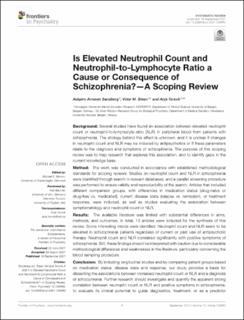Is elevated neutrophil count and neutrophil-to-lymphocyte ratio a cause or consequence of schizophrenia?—a scoping review
Journal article, Peer reviewed
Published version

View/
Date
2021Metadata
Show full item recordCollections
- Department of Clinical Science [2375]
- Registrations from Cristin [10186]
Abstract
Background: Several studies have found an association between elevated neutrophil count or neutrophil-to-lymphocyte ratio (NLR) in peripheral blood from patients with schizophrenia. The etiology behind this effect is unknown, and it is unclear if changes in neutrophil count and NLR may be induced by antipsychotics or if these parameters relate to the diagnosis and symptoms of schizophrenia. The purpose of this scoping review was to map research that explores this association, and to identify gaps in the current knowledge base.
Method: The work was conducted in accordance with established methodological standards for scoping reviews. Studies on neutrophil count and NLR in schizophrenia were identified through search in relevant databases, and a parallel screening procedure was performed to ensure validity and reproducibility of the search. Articles that included different comparison groups, with differences in medication status (drug-naïve or drug-free vs. medicated), current disease state (relapse vs. remission), or treatment response, were included, as well as studies evaluating the association between symptomatology and neutrophil count or NLR.
Results: The available literature was limited with substantial differences in aims, methods, and outcomes. In total, 13 articles were included for the synthesis of this review. Some interesting trends were identified: Neutrophil count and NLR seem to be elevated in schizophrenia patients regardless of current or past use of antipsychotic therapy. Neutrophil count and NLR correlated significantly with positive symptoms of schizophrenia. Still, these findings should be interpreted with caution due to considerable methodological differences and weaknesses in the literature, particularly concerning the blood sampling procedure.
Conclusion: By including longitudinal studies and by comparing patient groups based on medication status, disease state and response, our study provides a basis for dissecting the associations between increased neutrophil count or NLR and a diagnosis of schizophrenia. Further research should investigate and quantify the apparent strong correlation between neutrophil count or NLR and positive symptoms in schizophrenia, to evaluate its clinical potential to guide diagnostics, treatment, or as a predictor of outcome. This review also exposes important methodological weaknesses in the literature on neutrophil count and NLR measurements. Standardization of blood sampling and processing is crucial to reduce bias, and factors that are known to influence leukocyte levels need to be accounted for.
